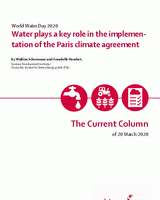World Water Day 2020
Water plays a key role in the implementation of the Paris climate agreement
Scheumann, Waltina / Annabelle HoudretThe Current Column (2020)
Bonn: German Development Institute / Deutsches Institut für Entwicklungspolitik (DIE), The Current Column of 20 March 2020
The United Nations (UN) is devoting this year's World Water Day to the topic of water and climate change. In so doing, the UN is underscoring the key role that water plays in climate change adaptation and in the reduction of emissions harmful to the environment. This has already been stressed by the 2015 Paris climate agreement. While climate change mitigation and climate change adaptation are two sides of the same coin, the Parties to the United Nations Framework Convention on Climate Change must use different packages of measures to combat them. This is anything but trivial and will be impossible to achieve without the support of international institutions. The countries of the world also face the challenge of taking account of water’s key role as a resource for implementing the UN’s Sustainable Development Goals (SDGs). Without sustainable water management, both food production and electricity generation, let alone drinking water supplies, are at risk.
Climate change is making itself felt in longer and more frequent periods of drought, in flooding and, at a very general level, in changed precipitation regimes. All of this is sufficiently familiar. Consequently, 102 member states are already classifying the water sector as vulnerable in their nationally determined contributions (NDCs). Extreme weather conditions are mentioned in 93 NDCs. Flooding is categorised as a climate risk by 97 countries and drought by 83. Over two thirds of NDCs include adaptation measures. Management approaches and technologies for ensuring a reliable water supply and incentives with the potential to promote sustainable water use are familiar, though not always used.
The example of agriculture illustrates particularly well how the climate and sustainability agendas are linked. SDG 2 seeks to end global hunger, which implies that farmers should prepare for water surpluses and water shortages in order to produce enough to meet global demand for food. Even now, marked fluctuation in rainfall is making it more difficult to grow food in sub-Saharan African countries. In many regions, rainfall levels are simply insufficient and droughts common. Investment in additional water storage facilities and irrigation infrastructure could allow food cultivation to continue even when rainfall is unreliable. “Irrigation is our insurance. If rains are late or if they stop at the wrong time, the consequences are severe. Irrigation eliminates that risk” – said a farmer from Zambia. In this case, access to financial resources is crucial.
Nonetheless, it is necessary to take account of the aspect of water regulations at the same time. When it comes to approving different uses of water, national water authorities must be able to respond flexibly both to growing sectoral demand and to changes in precipitation without excessively restricting people’s rights to water. Additionally, they should not exclude smallholders from the issuing of permits, as is the case in many sub-Saharan Africa countries, otherwise they have no water rights.
Effective national water policy must now adopt the following main strategies:
Get better at what we do: There is no need to reinvent the water policy wheel. Many technological solutions and management options are designed to ensure that water is used more carefully and efficiently, creating scope for adapting to the effects of climate change. Governments and the private sector should invest more in water infrastructure and old facilities and expand domestic and agricultural supply.
Take an integrated approach to water, climate and SDGs: Expertise and instruments need to be deployed in order to connect climate change mitigation objectives with efforts to implement the SDGs. Many of the NDCs include preventative measures, which go hand in hand with high levels of water consumption and intervention in the water supply. This is the case when new drinking water storage facilities are built without taking account of the adverse impact of the reduced water run-off on ecosystems and users downstream.
Adopt a more holistic and efficient model of global water governance: As our study shows, the current architecture is incoherent: Many organisations within the UN are concerned with different aspects of water as a resource. Two innovations at UN level could help to resolve this issue: an intergovernmental organisation which pools and coordinates decisions at UN level, and an expert committee which improves dialogue between researchers and practitioners in the water sector.
The Committee on World Food Security should address the topic of water tenure and formulate policies such as the Voluntary Guidelines on the Responsible Governance of Tenure of Land, Fisheries and Forests in the Context of National Food Security.
Let’s make water management fit for the future by pursuing these approaches and supporting them politically and financially.


